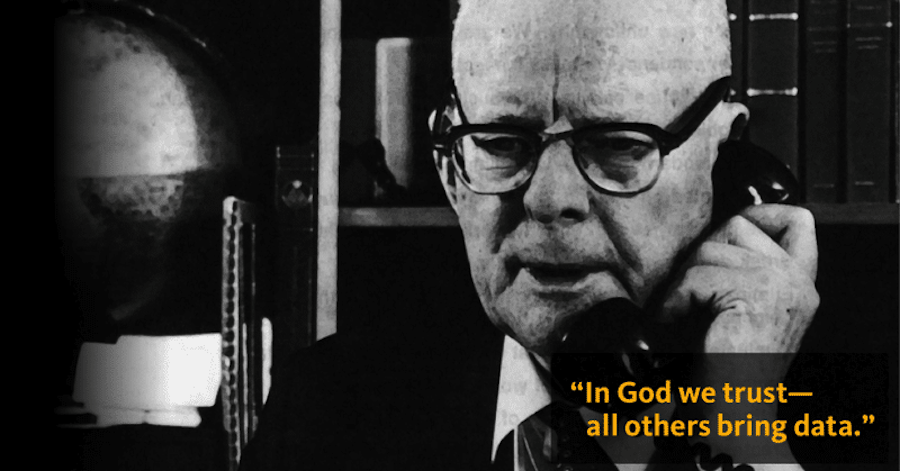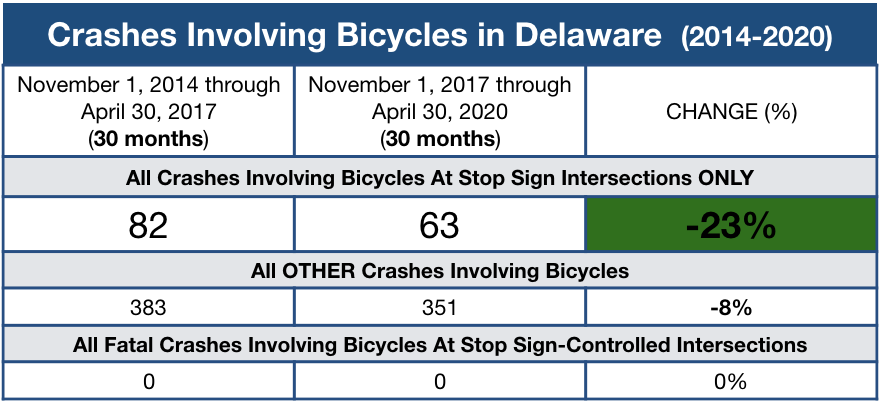In God we trust. (All others bring data.)
By James Wilson
Executive Director | Bike Delaware
The Cape Gazette and WRDE Coast TV both report: Delaware’s safe yielding law for cyclists is “controversial” in Lewes.
I saw that controversy for myself a couple of weeks ago when I testified to the Mayor and Council of the City of Lewes, who had put Delaware’s safe yielding law on their agenda. As Cape Gazette reporter Nick Roth wrote, I pointed out to the Mayor and Council that data from the Delaware State Police showed that bicycle-involved crashes at stop sign intersections dropped more than 20% after the safe yielding law was enacted in 2017. “This data actually exists. We don’t have to go with what feels right…We actually have the data,” I told them.
In God we trust. (All others bring data.)
Before I became Bike Delaware’s first executive director a decade ago, I had a previous career working as a research engineer in the private sector. Many engineers are familiar with with this quote from American engineer William Edwards Deming:

After Governor Carney signed the Bicycle Friendly Delaware Act (which included the safe yielding law for cyclists) into law in October of 2017, data from the Delaware State Police shows that crashes involving people using bicycles dropped specifically at stop sign-controlled intersections by more than 20% (even as the number of all other crashes involving bicycles in Delaware stayed about the same). That’s as close as it’s possible to get to a controlled scientific experiment on the effect of a law in the world of traffic operations engineering.

Why Delaware’s safe yielding law reduces crashes and injuries: Increased VISIBILITY and Reduced EXPOSURE
For cyclists, the safety value of Delaware’s safe yielding law (the “Delaware Yield”) is intuitive. It fits with our everyday riding experience. But for people who experience Delaware streets primarily from behind a vehicle windshield, why a more “permissive” Rule of the Road actually makes our streets safer may be more difficult to understand and appreciate. So here’s what’s happening: There are two general strategies for cyclists to reduce risk at intersections:
(1) increase our VISIBILITY to drivers and
(2) reduce our EXPOSURE (i.e decrease the amount of time we spend in an intersection).
The Delaware Yield maneuver enables cyclists to implement both of these strategies. By permitting cyclists to retain a modest amount of forward momentum, the law makes cyclists easier for drivers to see: Human visual perception has been evolutionarily optimized to be more sensitive to moving than stationary objects and it’s also easier for drivers to see things that are in front of them than to their side. And cyclists also reduce the total amount of time that we are exposed to a possible crash with vehicles, entering and exiting intersections more quickly than we could if we were required to always come to a complete stop.
Listen to the people who have the most at stake
When a vehicle and a bicycle are involved in a crash, the risk of injury to the driver of the vehicle and the person on the bicycle is – to use an engineer’s understated language – asymmetrical. No driver wants to be involved in any crash – even a minor one – but the stakes for cyclists in this discussion of Delaware’s safe yielding law are incomparably greater than for drivers. Our safety is literally on the line and we are, as a result, intensely motivated to get this right. In contrast, the Mayor and Council of the City of Lewes appeared to ignore the crash data that Bike Delaware provided two weeks ago when they voted to oppose the extension of Delaware’s safe yielding law. None of them mentioned the data or asked any questions about it. And some of them seemed more invested in talking about their experiences as drivers than in listening to what cyclists were telling them about our safety on Delaware’s streets.
Making our streets safer for people cycling shouldn’t be controversial
I regret that Delaware’s safe yielding law has become controversial among politicians in Lewes. I hope that controversy reflects some circumstances that are unique to Lewes and that people who live in the rest of Sussex County, and Kent County and New Castle County, are immune to the embarrassing confusion we are seeing in Lewes. Making our streets safer for people cycling shouldn’t be controversial.





3 Responses
Shame on Lewes and shame on the people who don’t want this because “cars have to stop, so they should too”.
It would be helpful if the people who oppose this law would give us specific reasons why they feel it is not appropriate to continue it. In other words their opinion or vote should be backed up by good solid reasoning. That reasoning should be stated so people could learn that they have conviction for the vote that they’re making rather than just a feeling or opinion. On a separate note as one who bicycles in Lewis all the time in every season I find that the drivers are extremely courteous and aware of us as cyclists and are prone to give the right of way in a gracious manner and I thank all of you for that.
James,
Good post, I miss your frequent posts of the past. Good job!
Bob E Ruddy (the oldest one)